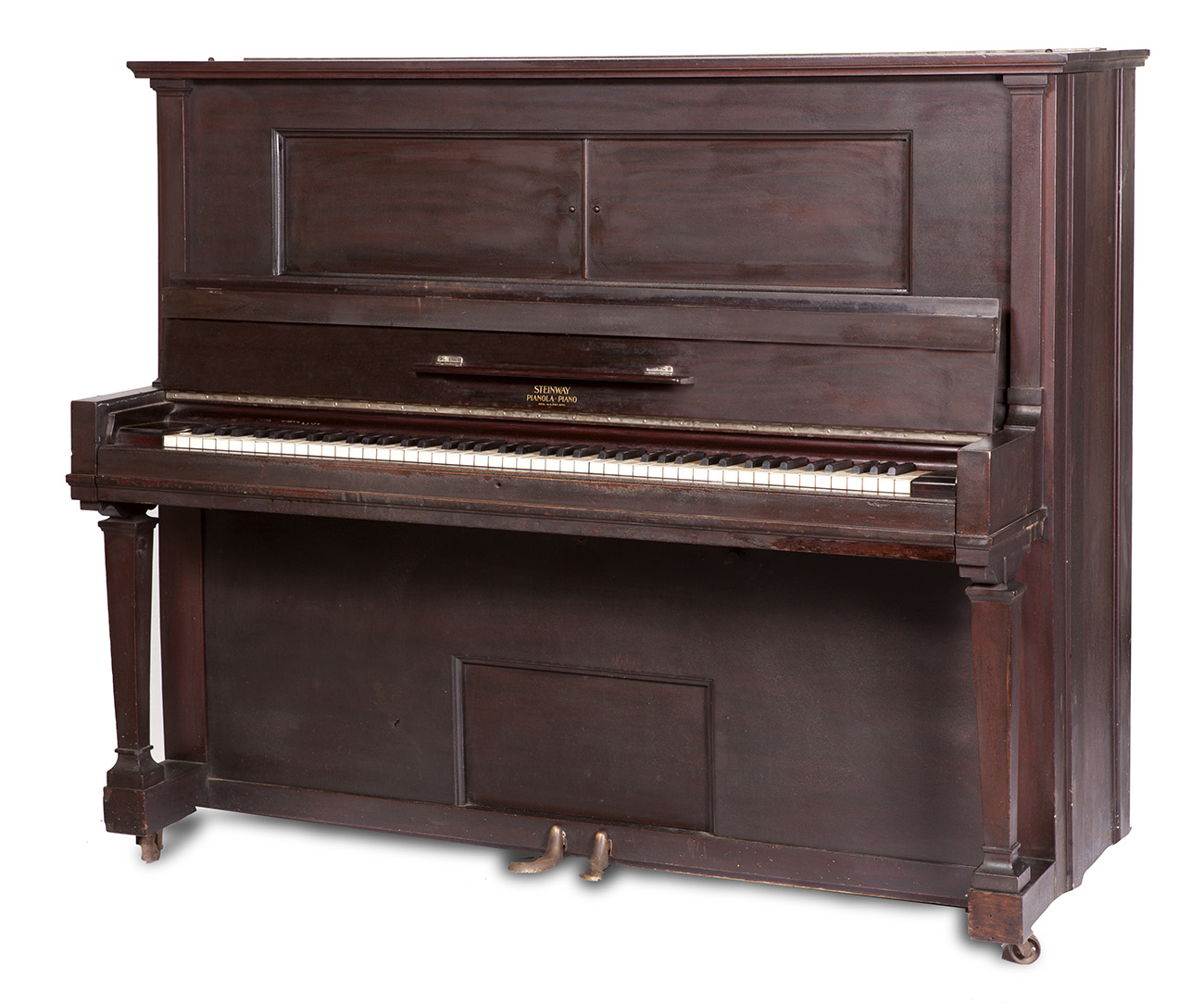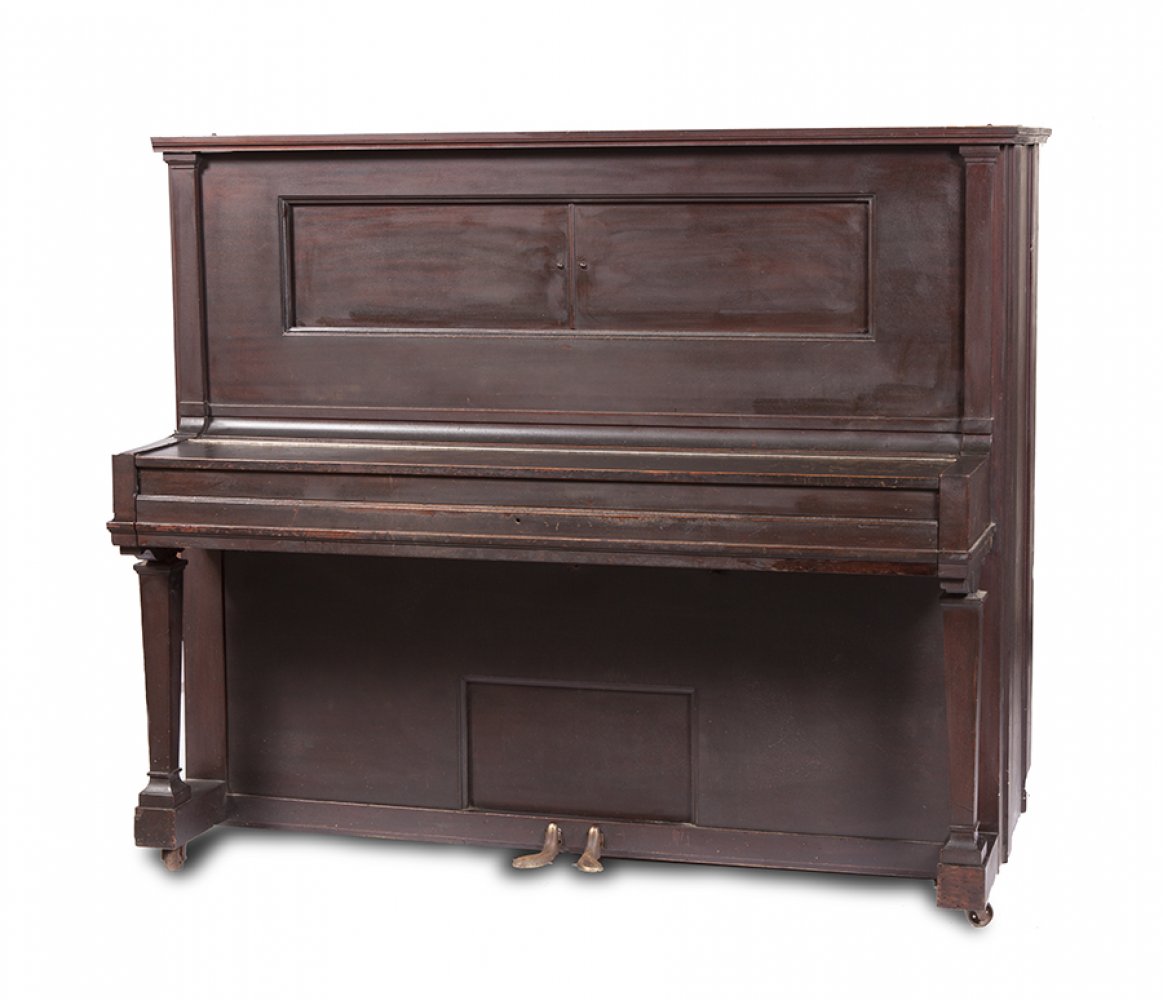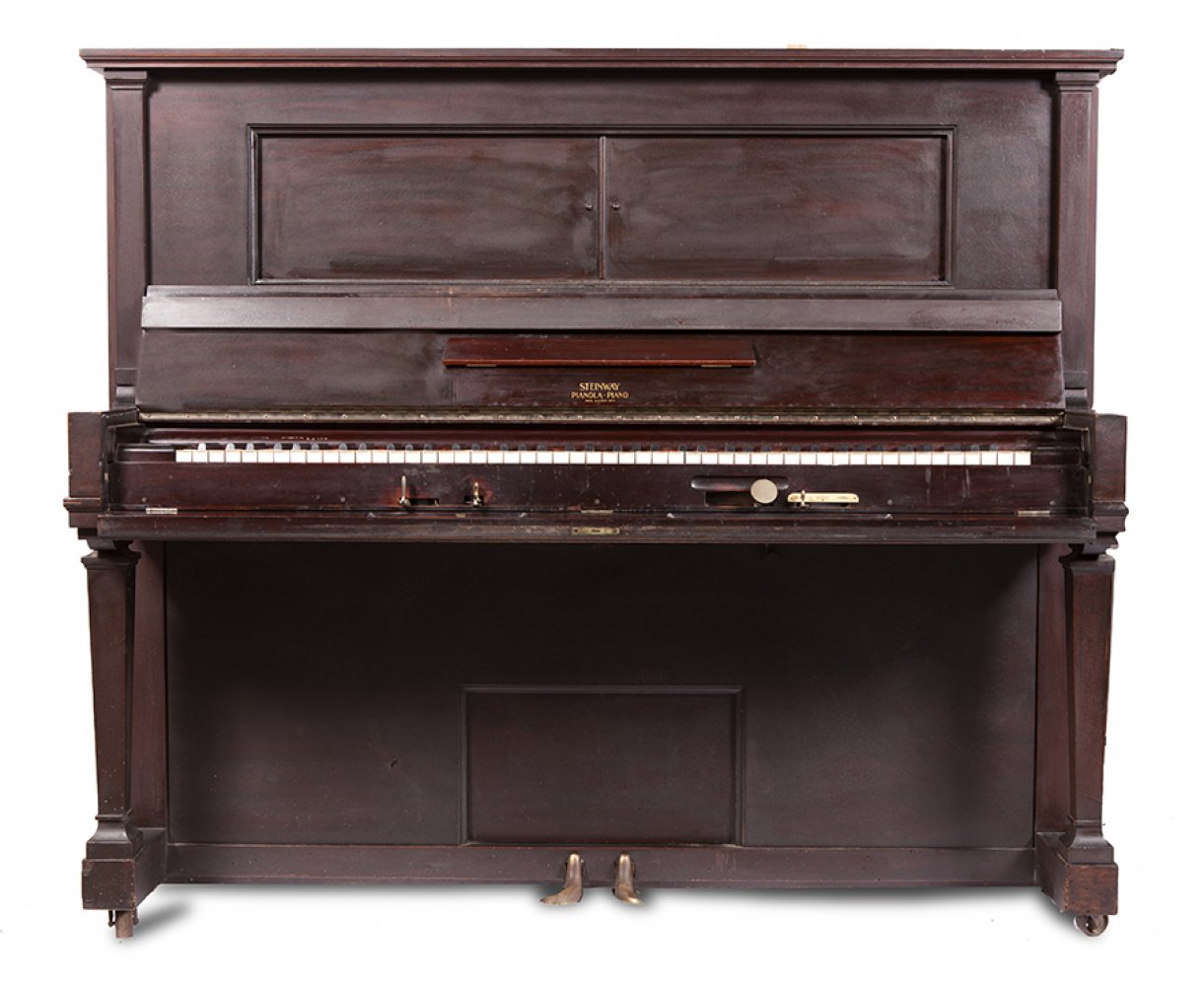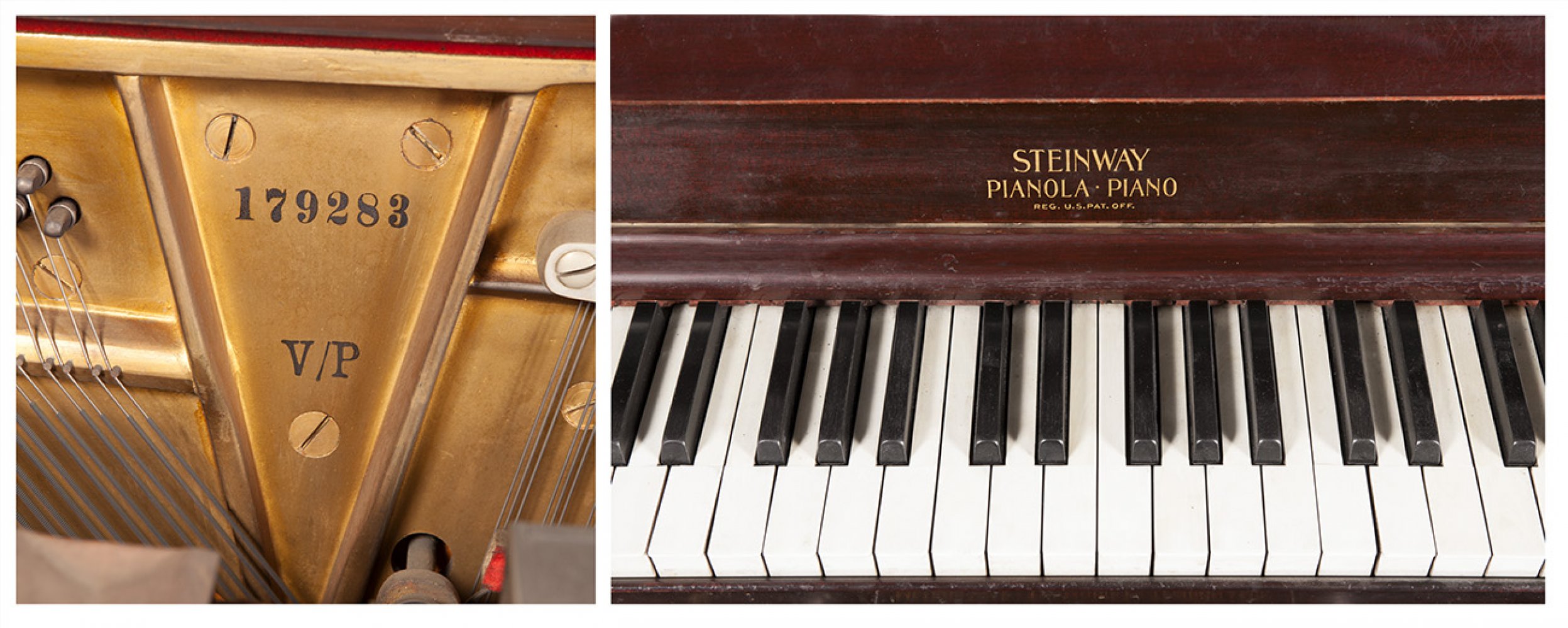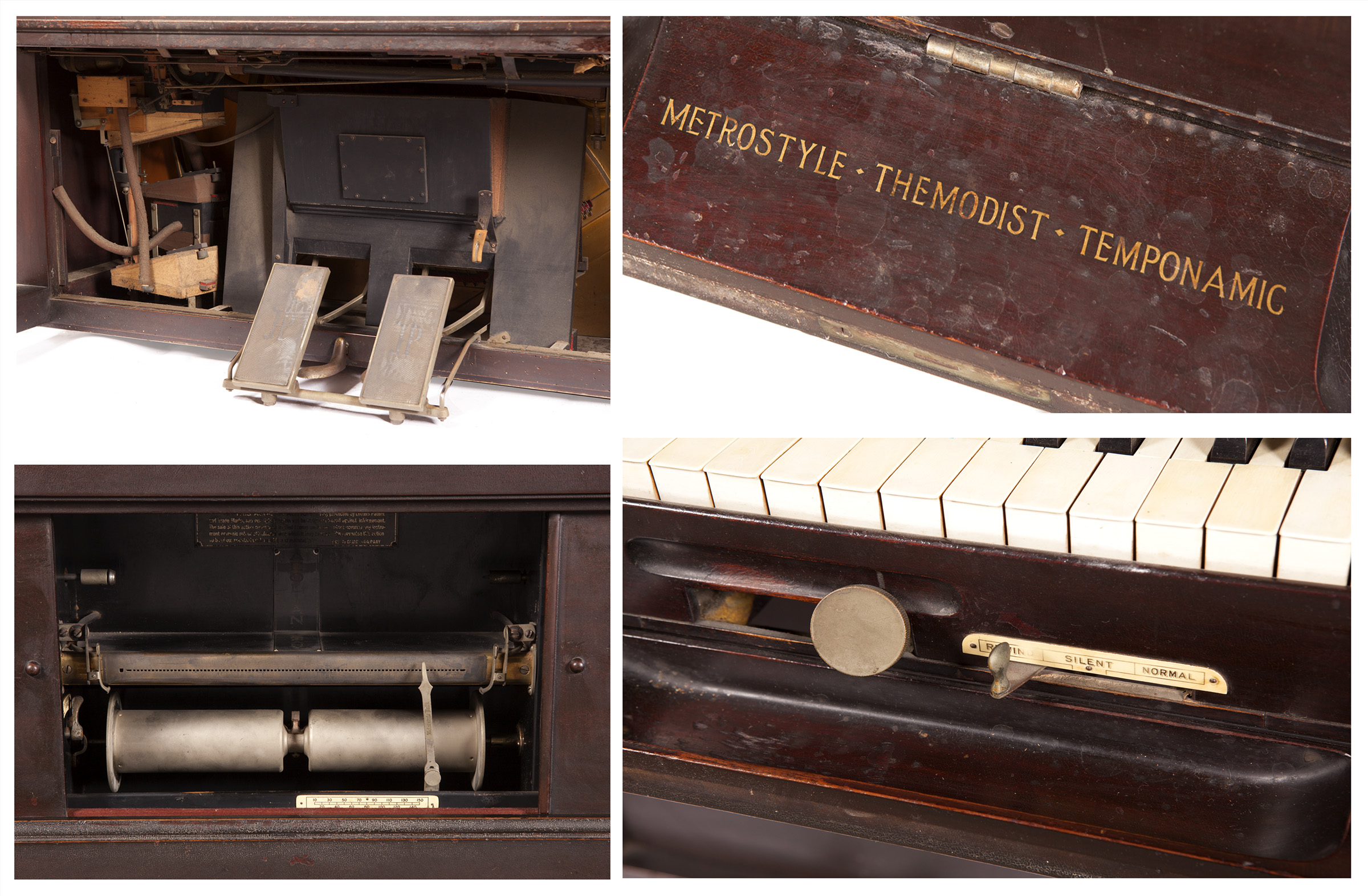115
STEINWAY pianola-piano, first quarter of the 20th century.Measurements: 134 x 159 x 77,5 cm.Early
Measurements: 134 x 159 x 77,5 cm.
Early 20th century pianola-piano with Aeolian's Metrostyle Themodist Temponamic playing system, in use between approximately 1913 and 1923. Aeolian Company mechanisms were mainly installed in pianos manufactured by the Aeolian Company, such as the Weber, Steck, Wheelock and Stroud. They were also available on Steinway pianos through an exclusive agreement. Aeolian had been under pressure to manufacture the mechanism for Steinway pianos, but Aeolian had no interest in establishing a relationship with a company it saw as direct competition. So, to satisfy Steinway, Aeolian agreed to stop promoting its Weber brand as a luxury piano firm, and also to stop sponsoring concerts by Paderewski and other great pianists of the day. The agreement also stipulated that Aeolian was to purchase a certain number of Steinway pianos per year, regardless of market demand.
The mechanical piano was invented in Paris by Debain around 1850. His system consisted of adding to an upright piano a second set of hammers set in motion by a system of levers. Other pianos were later built on similar principles. The model known simply as the handle piano became very widespread in Italy and England, and from the end of the 19th century a large number of different systems were produced, which competed for the clientele of non-musician amateurs, cafés, etc. Later, the pianola, patented in 1898, would work with a compressed air mechanism.
Founded in 1853 in New York by the German immigrant Heinrich E. Steinweg, who by then had already made almost five hundred pianos, Steinway & Sons was one of the main firms responsible for the development of the modern piano, especially during the forty years following its founding, when the company developed almost half of the one hundred and twenty-five patents it holds. Steinway's revolutionary designs, as well as the exceptional quality of its workmanship, earned the firm important international recognition from the very beginning. From 1855 onwards, it won gold medals at many exhibitions in the United States and Europe, most notably the Grand Gold Medal of Honour at the Paris Exposition of 1867. Steinway & Sons was the first American company to receive such a medal, and soon became the favourite of many members of the European aristocracy and the world's greatest pianists. To avoid import costs, Steinway opened its first European factory in 1880, in the German city of Hamburg. Ten years later, the company obtained its first royal warrant, from Queen Victoria of England. In the following years, Stewinway's client list would include the Prince of Wales and other members of European royalty and nobility. Soon it would also become a supplier to many other European royal houses, including Italy, Norway, Russia, Spain and Sweden, and even, in the East, to the Persian royal house.
Measurements: 134 x 159 x 77,5 cm.
Early 20th century pianola-piano with Aeolian's Metrostyle Themodist Temponamic playing system, in use between approximately 1913 and 1923. Aeolian Company mechanisms were mainly installed in pianos manufactured by the Aeolian Company, such as the Weber, Steck, Wheelock and Stroud. They were also available on Steinway pianos through an exclusive agreement. Aeolian had been under pressure to manufacture the mechanism for Steinway pianos, but Aeolian had no interest in establishing a relationship with a company it saw as direct competition. So, to satisfy Steinway, Aeolian agreed to stop promoting its Weber brand as a luxury piano firm, and also to stop sponsoring concerts by Paderewski and other great pianists of the day. The agreement also stipulated that Aeolian was to purchase a certain number of Steinway pianos per year, regardless of market demand.
The mechanical piano was invented in Paris by Debain around 1850. His system consisted of adding to an upright piano a second set of hammers set in motion by a system of levers. Other pianos were later built on similar principles. The model known simply as the handle piano became very widespread in Italy and England, and from the end of the 19th century a large number of different systems were produced, which competed for the clientele of non-musician amateurs, cafés, etc. Later, the pianola, patented in 1898, would work with a compressed air mechanism.
Founded in 1853 in New York by the German immigrant Heinrich E. Steinweg, who by then had already made almost five hundred pianos, Steinway & Sons was one of the main firms responsible for the development of the modern piano, especially during the forty years following its founding, when the company developed almost half of the one hundred and twenty-five patents it holds. Steinway's revolutionary designs, as well as the exceptional quality of its workmanship, earned the firm important international recognition from the very beginning. From 1855 onwards, it won gold medals at many exhibitions in the United States and Europe, most notably the Grand Gold Medal of Honour at the Paris Exposition of 1867. Steinway & Sons was the first American company to receive such a medal, and soon became the favourite of many members of the European aristocracy and the world's greatest pianists. To avoid import costs, Steinway opened its first European factory in 1880, in the German city of Hamburg. Ten years later, the company obtained its first royal warrant, from Queen Victoria of England. In the following years, Stewinway's client list would include the Prince of Wales and other members of European royalty and nobility. Soon it would also become a supplier to many other European royal houses, including Italy, Norway, Russia, Spain and Sweden, and even, in the East, to the Persian royal house.
20th October - Decorative Arts
Sale Date(s)
Venue Address
General delivery information available from the auctioneer
Setdart offers Worldwide shipping
PICK UP IN ROOM: You can come and pick up your lots in our offices (Barcelona, Madrid or Valencia). At the moment of the withdrawal, you will be able to accept the current conditions of the lot by means of a document that you will sign.
YOU CAN SEND ANOTHER PERSON TO PICK UP: This person must present a signed authorization that you can find in our web page by accessing from BUY AT SETDART- LOGISTICS-DOWNLOAD AUTHORIZATION DOCUMENT. You can also send an e-mail with the requested data in AUTHORIZATION DOCUMENT to admin@setdart.com
Important Information
25% buyer´s premium
21% buyer´s premium at www.setdart.com
Terms & Conditions
The maximum period to pay the lots is 7 working days. You can pay either via bank transfer or with credit card through our platform www.setdart.com (we only accept VISA or Mastercard).
BUYER´S PREMIUM: 22% Hammer price + 21% VAT from the buyer´s premium
If your piece has more than 100 years, our Ministry of Culture requires an export certificate in order for the piece to leave the country. Note that if the piece goes inside the EU, there is no cost for the export certificate. If the piece goes outside the EU, there is a cost for the export certificate. You can find more information in our Ministry of Culture website: https://www.culturaydeporte.gob.es/en/cultura/patrimonio/exportacionimportacion/exportacion/tasas.html
INQUIRIES: admin@setdart.com
Setdart guides you through the entire process, from the time of award to the day you receive your lot. Our logistics team will be happy to manage your transport, and will advise you on the best shipping method with professionals from the sector used to handling works of art and jewelry.
WE OFFER WORLDWIDE DOOR TO DOOR SHIPPING
PICK UP IN ROOM: You can come and pick up your lots in our offices. At the moment of the withdrawal, you will be able to accept the current conditions of the lot by means of a document that you will sign.
YOU CAN SEND ANOTHER PERSON TO PICK UP: This person must present a signed authorization that you can find in our web page by accessing from BUY AT SETDART-LOGISTICS-DOWNLOAD AUTHORIZATION DOCUMENT. You can also send an e-mail with the requested data in AUTHORIZATION DOCUMENT to admin@setdart.com
SETDART IS NOT RESPONSIBLE FOR THE STATE OF THE PARTS ONCE THEY LEAVE OUR FACILITIES. MRW SHIPMENTS: Once the payment is made, your lot will be packed for shipment, the logistics department will send you an e-mail notifying you of the day it leaves our warehouse, changes of address cannot be made after receiving this e-mail.
INSURANCE INCIDENTS: Coverage for the value of the auction up to 3000 ? per shipment, if the value of the auction is higher, Setdart will send you a quote including the additional insurance. The insurance company WILL NOT BE RESPONSIBLE FOR THE SHIPMENT THAT EXCEEDS THAT AMOUNT AND IS NOT FULLY INSURED. MRW INCIDENTS: Maximum notification 48 hours after receipt, after which the insurance company WILL NOT BE RESPONSIBLE AND NO CLAIMS WILL BE ACCEPTED.
E-MAIL LOGISTICS: logistica@setdart.com
PICK UP YOUR MESSAGES: You can send your own messaging, prior notice via e-mail that your shipment is ready, please note 3 or 4 days in advance. This type of shipment is packaged so Setdart will provide you with a quote.
EXPENSES FOR STORAGE: We inform you that if the purchased lot is not picked up within a month, you will be charged 30€ per week per lot. Setdart Online S.L., owner of the web site "setdart.com", "setdart.net" and "setdart.org", acts as a company of Spanish nationality inscribed in the Volume 36955, sheet 182, page B-293056 of the Mercantile Registry, with registered office at Calle Aragó













